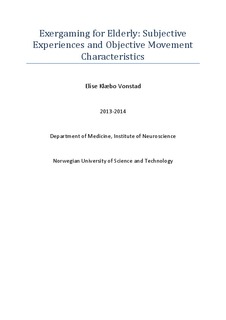| dc.description.abstract | Background: It is important for elderly to stay healthy and independent for as long as possible, and falls are a major cause for loss of independence. Physical activity aimed at improving balance that includes large movements and cognitive tasks has been shown to decrease fall risk. Using exergames as a training tool has increased in recent years, but the actual movements elicited by such exergames have yet to be investigated objectively.
Aim: To investigate usability and enjoyment and provide objective quantification of movement size elicited by two exergames.
Methods: Twenty healthy elderly (mean age 74.4, range 65-90) played two exergames, The Mole (SilverFit) and LightRace (YourShape: Fitness Evolved) at easy and medium level, with five trials of one minute at each level. Data on perceived exertion (BORG), enjoyment and system usability (SUS) was collected.. Movements were captured using OQUS Motion Capture System, with passive reflexive markers attached to the base of the 1st toe, heel and lumbar area of the back. Movement size was expressed as Interquartile range (IQR) of feet and trunk in all three directions, and as horizontal area covered by the lumbar and toe markers. Correlational analyses were performed to investigate relationships between game scores, BORG-scores, SUS-scores, IQR and area coverage. Repeated measures ANOVAs were used to analyze effects of game, level, and trial.
Results: Both games scored high on usability, and the elderly perceived the games as enjoyable, relevant as physical activity, and not very exhausting. Game scores increased across trials and decreased from easy to medium levels. Nevertheless, participants preferred the medium over the easy levels because of the increased cognitive challenge. IQR and area in the feet exceeded those in the trunk, especially in the medio-lateral direction. There were no significant correlations between game score and movement variables.
Discussion: The positive attitude from the participants is promising for future implementation of exergames into fall preventive exercises. However, the lack of correlations between game scores and movement variables indicate that although these exergames do not reward players for "cheating" movements; they have room for improvement concerning rewarding desired movements.
Keywords: older adults, exergames, movement characteristics, stepping. | nb_NO |
